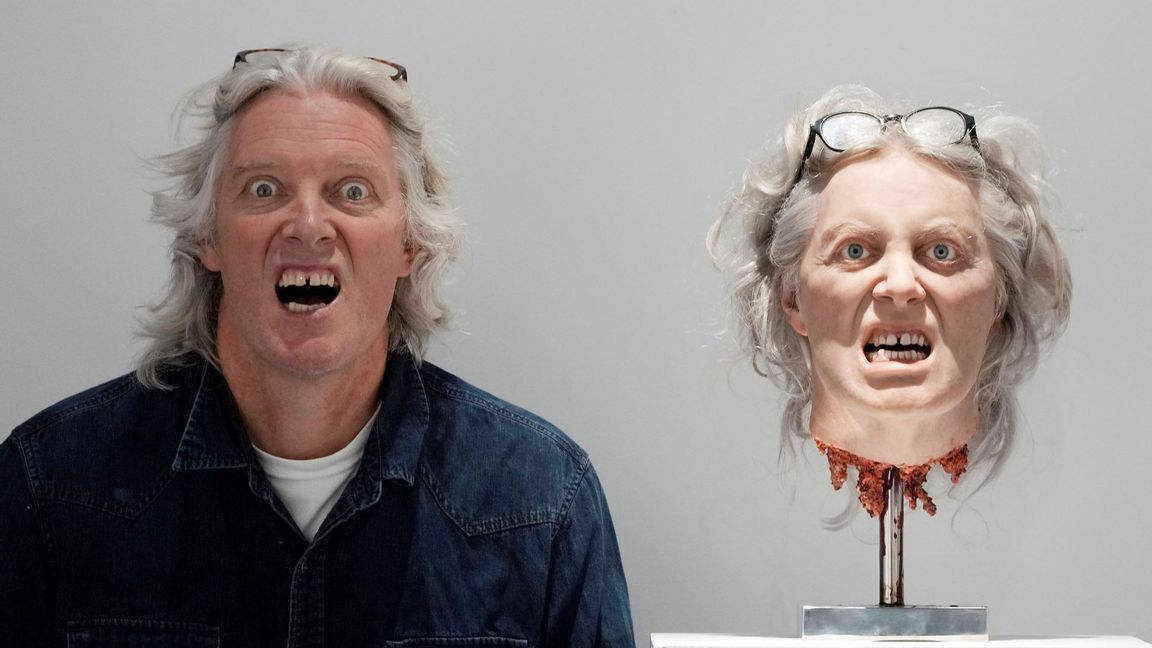
WARSAW, Poland (AP) — An exhibition at a Polish state museum that opened Friday features the works of provocative artists in what organizers describe as a celebration of free speech, and a challenge to political correctness and “cancel culture” on the political left.
Some critics, however, accuse organizers of giving a platform to antisemitic and racist messages under the pretense of defending freedom of expression.
“Political Art,” which features the works of nearly 30 artists, is the second exhibition at the Ujazdowski Castle Center for Contemporary Art under director Piotr Bernatowicz, who was appointed by Poland’s populist conservative ruling party in 2019.
Since it came to power in 2015, the Law and Justice party has harnessed the country’s cultural institutions in a mission to promote conservative and patriotic values — including the art center housed in a reconstructed castle that has showcased experimental and avant-garde art in Warsaw for 30 years.
The museum says the “Political Art” show provides a space for rebellious artists sometimes shunned elsewhere. The exhibition includes works critical of the authoritarian regimes in Russia and Belarus, works by women from Iran and Yemen critical of oppression in the Muslim world, and others that use swastikas or symbols rooted in the Holocaust in an apparently ironic way.
The most controversial person included is Dan Park, a Swedish provocateur who has been jailed on hate crimes in Sweden. In 2009, Park placed swastikas and boxes labeled “Zyklon B” — the gas used in the mass murder of Jews during the Holocaust — in front of a Jewish community center in Malmo.
A demonstration took place outside the museum as visitors arrived for the opening, with protesters confronting Park and one large banner saying: “State promotion of fascism.”
The Jewish community in Poland strongly protested the inclusion of Park. In an open letter to the museum director, rabbis and other Jewish representatives argued that promoting such artists offends all people in a country where 6 million Polish citizens — half of whom were Jews — were murdered during World War II.
“Free expression is essential to a democratic society, but free expression still has limits,” Poland’s chief rabbi, Michael Schudrich, said.
At a news conference on Friday, the director, Bernatowicz, said he could understand the position of the Jewish organizations, acknowledging that some of the work is provocative and controversial. But he said the Jewish representatives should see the exhibition before criticizing it.
“I am not creating a platform propagating any types of Nazi or neo-Nazi views,” Bernatowicz said. “I am creating a platform for art to be expressed.”
Several artists at the news conference said they received emails from antifascists the day before, warning them that works were being shown by far-right artists.
Some said they were unsettled by that message, including Emma Elliott, an antifascist artist whose works explore how women are usually the first targets of fascist regimes. But she and the others present — including two Jewish artists — defended the exhibit as an important platform for different voices.
“Yes, I find some of the images here not only disturbing but offensive,” said Marc Provisor, an Israeli artist. “But I think it’s important for the writers of those letters to come (and) face what disturbs you.”
Separately, an anti-fascist network in Poland also condemned “the attempts to use Polish art institutions to platform artists infamous for their neo-Nazi sympathies.”
Among the works by Park being shown in Warsaw is a poster that presents Anders Behring Breivik, the right-wing extremist who killed 77 people in twin attacks in Norway, as a supposed model for the clothing brand Lacoste.
Another provocateur is Uwe Max Jensen, a Danish artist who did a performance at Friday’s opening in which he waved a Confederate flag, stripped naked, painted his body black with the help of another artist, and dragged himself on the floor as he repeated the words “I can’t breathe!” Those were the last words spoken by George Floyd, the Black man whose murder by a police officer triggered a racial reckoning in the United States.
Protesters surrounding him shouting “fascist!”
The exhibit also features works by Lars Vilks, a Swedish artist who lives under police protection for making a drawing of a dog with the head of the Prophet Muhammed. The drawing upset many Muslims in 2007 and brought Vilks death threats from extremists.
Ahead of the opening, a Yemeni-British artist who has also received death threats for works critical of Islam, Tasleem Mulhall, met Vilks for the first time. When she learned of his background, she hugged him and told him she admired him.
Also included in “Political Art” is a wall of photos of Ugandans holding up IDs. It is part of a project by Danish conceptual artist Kristian von Hornsleth, who persuaded 340 Ugandan villagers in 2006 to legally change their names to Hornsleth in exchange for pigs and goats.
Hornsleth — the artist who helped apply black pain to Jensen’s body — said the work was a critical commentary on the inability of Western development aid to help people in Africa, but some saw his work as racist.
Co-curator Jon Eirik Lundberg, a Norwegian who runs the Laesoe Kunsthal gallery in Denmark, denied that the show promotes racism, and said its aim is to fight for freedom of speech in defense of democracy.
“The best way to protect any minority is to make sure there is freedom of speech,” he said.
Hornsleth, the artist who photographed Ugandan villagers, said: “Even if this show was right-wing and crazy, it should be allowed because it’s art. But it’s not — it’s really about creating a space in which anybody can disagree about anything.”
“Political Art” runs through January 16.
By Vanessa Gera
See also: Ukraine leader stresses NATO, EU ties on independence day
See also: US WWII veteran reunites with Italians he saved as children